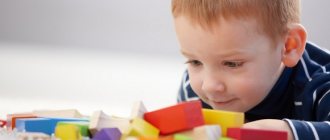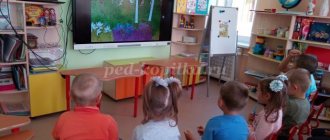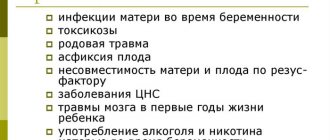The importance of speech development in children at preschool age
The development of speech in children is perceived by many adults as the main indicator of intelligence. This approach is explained by the fact that awareness and logic can be traced in statements and conversation. Of course, thinking and speech as mental processes are closely interrelated. But speech development is only part of the intellectual level of an individual.
At the same time, for a preschooler speech is a multifunctional tool. With its help, he receives information and establishes contact with the outside world. Words help the child consolidate the result of objective activity in his mind. Thanks to speech, children come to perceive and use images.
The speech of a preschooler is egocentric and spontaneous. He speaks more to himself, using repetition and monologue. It's like thinking out loud, with the pronunciation of which comes understanding. Words serve as an activity enhancer and support the child in his actions.
For preschool children, the cognitive and communicative functions of speech are equally important. By listening to adults, they absorb information and discover the world around them. At the same time, children learn to speak and strive to be understood.
Formation of word formation skills
At the age of 5, the child begins to use all the main parts of speech in communication. He carries out the gradual formation and development of word formation in preschoolers. Children are in the process of activating their vocabulary, and children begin to use words meaningfully. Preschoolers improve their word inflection.
5-6 years is the period of active development of the phonetic side of speech. Children already have the ability to divide words into syllables and fill words with sounds. Mistakes are made only in words unfamiliar to children.
Speech development tasks
The psycho-speech development of a child occurs, first of all, due to the natural processes of maturation of the body and the formation of personality. Everything that a baby unconsciously guides while exploring the world is his needs. Adults understand perfectly well that a child must cover a considerable distance in speech development in just a few years. By the time it is time to go to school, a preschooler needs to:
- Know and use many words
- Speak clearly and coherently
- Using speech, receive various cognitive information
- Communicate with peers and adults
The listed tasks are the most important in the speech development of preschool children. They are resolved gradually at each age stage.
Features of speech development or what can be said about the components of speech activity?
M.R. Lvova noted that the components of speech activity include:
- speed of speech reactions during dialogue,
- selection of games that require the use of speech components,
- speed of word choice,
- features of statements.
And the conditions under which children’s speech is activated include: mastery of the language system at a certain speech level of development, the need and characteristics of communication in children, the inclusion of preschoolers in activities that are available for a specific age stage.
Psychological characteristics and stages of speech formation in preschool children
The psychological features of speech development in preschool children are determined by the fact that each year of their life sets its own pace and rhythm. The years of preschool childhood are filled with the development of actions, the formation of mental processes, and the accumulation of emotional experience.
If you compare what a child was like a year ago and what he became a year later, these changes are striking. Speech skills change dramatically over such a period of time. In a child’s active vocabulary, the number of words can almost double, and statements become figurative and emotional. Every year a preschooler moves to a new level of speech development.
Development of child speech from 3 to 4 years old
What kind of speech baggage do children enter the preschool age period with? They already know more than 1.5 thousand words. Their statements contain almost all parts of speech with a predominance of verbs and nouns.
The child is no longer content with showing actions, but strives to describe and explain them in words. Speech at 3-4 years of age is still ungrammatical. Individual words are combined awkwardly, reflecting solely the child's interest, need and desire. No logic or conclusions can be traced at this stage. The sentences are simple and short.
The child’s thinking is still strongly tied to the visual situation and is based on momentary impressions. Therefore, his speech is situational. This means that without external clues in the form of surrounding objects or phenomena, it is difficult to understand what the baby is talking about.
The child’s phonemic hearing has already been formed, but many sounds are not yet pronounced due to complex articulation. It is especially difficult to cope with words where there are several consonant sounds in a row. Children distort such difficult moments or skip them altogether.
Formation of speech skills in children from 4 to 5 years old
A 4-year-old preschooler has a significant vocabulary and actively uses simple sentences. In some sound combinations it is possible to pronounce sibilants, but the pronunciation is still unstable. The child persistently repeats if those around him cannot understand what he is talking about.
An orientation towards the sound of the word is formed. Children begin to come up with meaningless words, but in such a way that they create a funny rhyme: porridge-baby, kitten-potten...
This desire to look for speech analogies is called word creation. It gradually becomes more active, starting from the age of 3, and is most clearly manifested by the age of 4.5-5 years. This is an original practice that helps the child learn a lot about his native language through experimentation. The appearance of word creation is a sign that the preschooler is beginning to acquire primary literacy skills.
By the age of 5, the grammatical structure of speech in statements acquires a new level. The preschooler composes complex sentences, takes into account the order of words, uses words in the appropriate cases, changes by gender and number.
But not all grammatical forms are distinguished yet. Even five-year-olds, without thinking, can use “I’m taller than Kolya,” “my pencil is thinner,” and other similar statements.
Features of speech development of a preschooler aged 5-7 years
Speech skills rise to a new level in older preschool age, when situational simple sentences are gradually replaced by coherent speech.
Speech that is connected by semantic content is called coherent or contextual. This content quite fully reveals the speaker’s thought or intention, and the thought is expressed in consistently and correctly constructed sentences.
The cognitive speech development of older preschoolers allows them to express their thoughts in understandable language. At this age, children speak with a listener in mind.
A 6-year-old learns speech planning. If earlier words accompanied the action or followed them, then in older preschool age they come to the fore. The preschooler first thinks through and tells what he intends to do.
An important achievement is the emergence of speech forms of activity. The older preschooler perceives listening, telling, reading, and reasoning as activities.
The importance of speech communication in preschoolers
The development of speech in preschoolers helps to expand the social circle of children of older preschool age. They talk a lot with family and close adults. Their speech becomes more expressive and has its own characteristics. Their communication with unfamiliar adults also develops. With the help of speech, children of senior preschool age are actively involved in communication with other children during play and independent activity.
The child's speech is often accompanied by objective actions. For example, a child takes a toy and begins to comment on his actions. Such a statement and such communication may seem to be simply a statement of the child’s action. But this form of speech plays a huge role in the development of a child’s thinking. This shows that the preschooler’s verbal communication is expanding, the baby begins to think and reflect using words and phrases. Features of speech development in this case show the maturity of the thinking of a child of senior preschool age.
Older preschoolers are interested in the speech and statements of adults. They listen carefully, noting only statements about themselves, not only speech that is addressed directly to them, but also listen with interest when adults speak with other children and with each other.
Until the end of the visit to the preschool educational institution, the verbal communication of a preschooler of senior preschool age can remain at the level of situational communication. In most cases, children of senior preschool age have not developed verbal communication on personal topics at all. And thus, they communicate purely emotionally and directly, which by and large characterizes the characteristics of communication of very young children. In behavior, preschoolers, of course, are not like babies, but they like it more when an adult simply strokes and caresses them, and in verbal communication they are often embarrassed, withdrawn into themselves, or even refuse to communicate. This is natural for a baby under one year old, but when this form of communication persists up to 5 years, it should be alarming, it indicates a developmental delay and shows that speech is not fully formed.
The majority of children of senior preschool age have speech development disorders. Children may comment on their actions during certain activities, but most often only when asked. Children most often do not show their own initiative in speech.
Norms of speech development in a preschooler from 3 to 7 years old
The results of studies of the speech of preschoolers make it possible to establish average indicators. Let's consider what levels of speech development are expected at each age stage - for younger, middle and older preschoolers. For convenience, we present the data in a table.
Table. Approximate norms for speech development of preschool children
| Age | Lexicon | Level of speech development |
| 3-4 years | up to 1900 words | Speech is situational, using indefinite forms there, like that. Makes simple sentences. Uses verbs, nouns and pronouns (often demonstrative this, that). Pronunciation: softens the sound, does not pronounce the sound R, less often – L, K, G. replaces hissing sounds with whistling ones. |
| 4-5.5 years | 2000-2500 words | Expands the use of adjectives. Literally understands the meaning of the word. He is interested in the sound of words, composes rhymes and new consonant words. Uses diminutive suffixes. Uses conjunctions a, and, but, as well as subordinates that, when, because... Expresses quantitative and qualitative relationships: many-few, high-low... Pronunciation: overcomes softening, masters almost all sounds, partially copes with the pronunciation of R. |
| 5.5-7 years | up to 4000 words | Speech is coherent and detailed. Composes messages from several sentences united by a common meaning. Builds sentences correctly from a grammatical point of view. Modifies words using suffixes. Masters the declension of nouns and the conjugation of verbs. Sound pronunciation must be correct. |
Methods for developing a preschooler's vocabulary
Methods through which a preschooler’s speech is enriched, expanded and its features are activated. One of the effective methods is a didactic game, which is always filled with objects. Children recognize them, can describe their quality, and talk about the purpose of the item.
I would also like to note that a teacher, when organizing speech development for older preschoolers, must adhere to the following stages: 1. Getting to know the child 2. Detecting speech errors 3. Planning a set of classes on speech development 4. Development and testing of various interesting forms of individual and group work on speech with elements of play as the leading type of activity for preschoolers of the senior and preparatory groups.
If you adhere to such a work plan, you can achieve successful and effective development of all types of speech of children within the preschool educational institution.
Before starting school, a child must acquire speech skills and master the grammatical structure of speech. This is the age when the child’s natural assimilation of syntactic and morphological order occurs.
Parents' activity in the development of their child's speech
It is important for parents to consider that each child has his own individual pace of development. Noticing problems in the development of speech in their child in the preschool period and some discrepancy with the norms, they should not jealously compare with others and catch up with their peers, at all costs. However, this issue cannot be ignored.
Parental assistance is necessary for a preschooler in cognitive and speech development. Children, with the support of their parents, successfully progress in the following areas:
- vocabulary formation
- word creation
- development of verbal description skills.
In everyday communication with a child, parents have hundreds of opportunities to use new concepts and explain what they mean. Such simple participation of adults will significantly expand the active vocabulary of a preschooler.
Word creation allows the child to better understand the language and contributes to the development of a sense of rhythm. In addition to benefits in speech development, this activity brings incredible pleasure to children. Emotional speech, joint invention of new words with mom or dad is always accompanied by laughter and a joyful mood.
Parents can successfully teach verbal descriptions to their child. An adult can tell stories and describe what is happening to a preschooler, giving an example of a coherent statement, and then invite him to similarly describe what he sees around him. These activities are easy to do and can be done in any environment - at home or on a walk.
What factors influence speech development
Factors influencing the development of a child's speech.
A child’s mastery of oral speech is determined by the following conditions:
- Heredity, structure of speech organs. Incorrect anatomy of the organs of the articulatory apparatus and undeveloped facial muscles complicate the development of speech in children 1-3 years old. Drinking through a straw and inflating balloons help strengthen your facial muscles. Whereas physiological problems are solved by medical methods.
- Correct functioning of the central nervous system, speech zone of the brain. Disturbances in the functions of the nervous system or Broca's center are often accompanied by delayed speech development in children. To develop these functions, exercises for fine motor skills are used.
- Pregnancy, childbirth without complications. Research confirms that anemia during gestation, premature birth before 35 weeks, hypoxia and other pathologies delay speech development at an early age.
- Contact with parents and close relatives from the first days of life. The foundation for future communication and healthy development of the newborn is a sense of security, physical closeness to the mother, and provision of physical and emotional needs.
- Constant interaction between parents and child. He learns about communication from changes in facial expression, movements, and gestures. Then he begins to perceive addressed speech, distinguish between emotions and voice intonations. Therefore, it is recommended to pronounce your actions, call the baby by name, and do not ignore babbling or crying.
Development of children's speech in different types of activities
The relationship between speech and the content of activity intensifies with age. The need for verbal expression differs in different types of activities.
While playing with his toy, the preschooler conducts a dialogue with it. This one-sided conversation can be internal, not expressed in words. But more often the child says out loud all his calls to his toy friend.
Playing with peers offers other conditions. It is necessary to contact your partner, it is also important to hear him and exchange information. If at younger preschool age verbal communication in the game is simple and may be limited to role-playing participation, then older preschoolers often use explanatory speech.
The speech of a preschooler, which presents a holistic message and fully describes the situation, is called explanatory.
Explanatory speech develops well when preschoolers agree on the rules of the game or coordinated actions and explain the structure of the toy.
The creative activity of a preschooler is also permeated with speech. A child's drawing often needs explanation. And not only due to the fact that the adult asks what is shown on the sheet. More often than not, the author himself wants to tell what he drew. Speech description invariably enriches the content of the picture. Or dots the i's if something incomprehensible is depicted.
With the help of speech, children convey the character of their characters, thus overcoming the limitations of their own artistic abilities.








